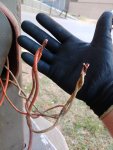James Lee
Member
- Location
- Dallas Texas
- Occupation
- Journeyman Electrician
We had an electrician get shocked working on a parking lot light pole at the hand hole junction, he's doing good, it doesn't look like a major injury, thank God he's good now.
When I arrived at the job site my supervisor arrived around the same time, he was acting frantic and asked me to turn off the power, I asked him where do you turn the power off at, he replied '' I don't know,'' so I capped off live wires and closed everything up so no one else would get injured or worse, he wrote me up on a SOCA which is a major write up saying I didn't secure power, I believe I secured power when I capped off the exposed wires as do many other electricians, supervisor's etc... I'm waiting on the NFPA for a response, I don't know if it's in the NEC-NFPA on a situation like this or if it could be added, what do ya'll think ?
Or what is the NEC'S interpretation
P.S. I know it would've taken a lot longer to look for the breaker than to make it safe on the spot like I did.
Thank you
Sincerely
James Leyba
When I arrived at the job site my supervisor arrived around the same time, he was acting frantic and asked me to turn off the power, I asked him where do you turn the power off at, he replied '' I don't know,'' so I capped off live wires and closed everything up so no one else would get injured or worse, he wrote me up on a SOCA which is a major write up saying I didn't secure power, I believe I secured power when I capped off the exposed wires as do many other electricians, supervisor's etc... I'm waiting on the NFPA for a response, I don't know if it's in the NEC-NFPA on a situation like this or if it could be added, what do ya'll think ?
Or what is the NEC'S interpretation
P.S. I know it would've taken a lot longer to look for the breaker than to make it safe on the spot like I did.
Thank you
Sincerely
James Leyba
Last edited:



